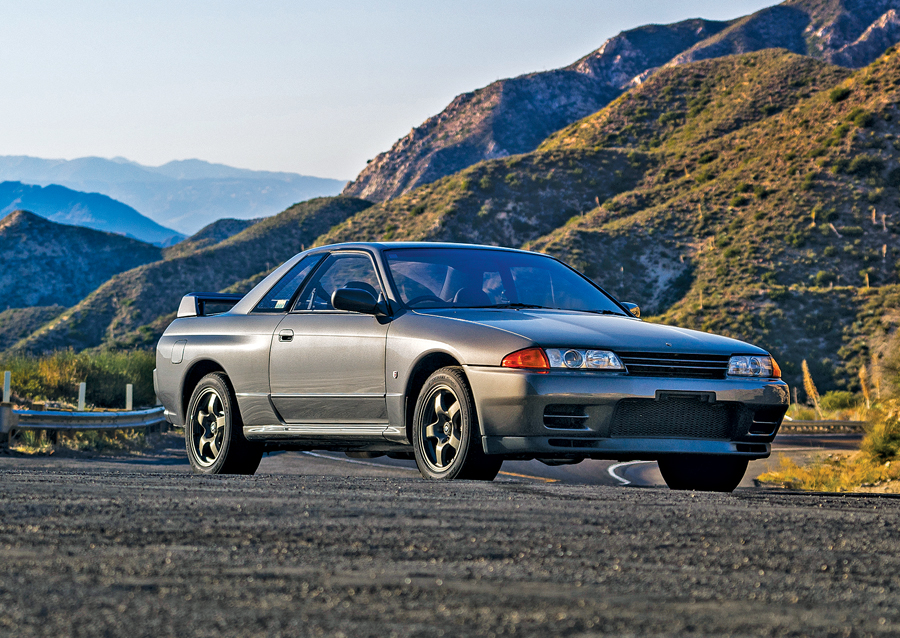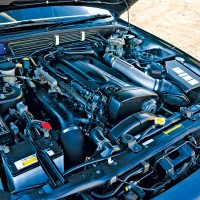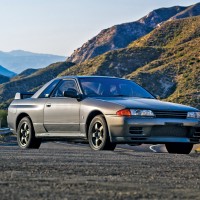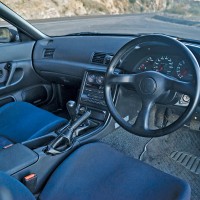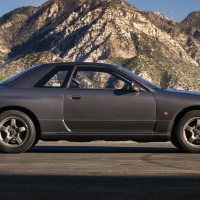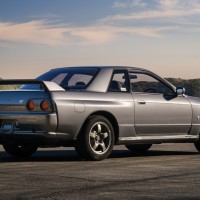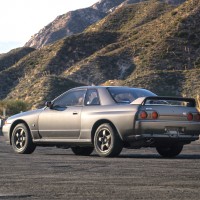- Single owner and less than 14,000 km (9,700 miles)
- All original and never modified
- The first year of the “Godzilla” GT-R
SCM Analysis
Detailing
| Vehicle: | 1989 Nissan Skyline GT-R |
| Years Produced: | 1989–94 |
| Number Produced: | 43,934 |
| Original List Price: | ¥4,445,000 ($35,392) |
| SCM Valuation: | Median to date: Does not apply, as there is only one sale — this one — in SCM’s Platinum Auction Database; high sale, $82,500 (this car) |
| Tune Up Cost: | $250 |
| Distributor Caps: | N/A |
| Chassis Number Location: | Engine bulkhead |
| Engine Number Location: | Bottom of block on inlet side |
| Club Info: | Nissan Skyline Owners Club |
| Website: | http://www.skyline-owners-club.com |
| Alternatives: | 1991 Lancia Delta Integrale Evoluzione, 1992 Ford Sierra RS Cosworth, 1996 Mitsubishi Lancer Evolution |
This car, Lot 174, sold for $82,500, including buyer’s premium, at RM Sotheby’s Phoenix, AZ, auction on January 28, 2016.
In August of 2014, a Japanese performance car of near-mythic legend turned 25 years old and became legal for U.S. import: the eighth-generation Nissan Skyline, known by its chassis code as the R32.
Video games…
The Skyline’s rise to U.S. pop-culture stardom illustrates the world-shrinking, border-shattering, culture-melding force of the Internet and video games.
Beginning in the late 1990s, game developers infused their electronic worlds with a new, exhaustive level of realism. The focus shifted from hucking imaginary race cars around crazy tracks, “Dukes of Hazzard” style, to mastering real-world driving dynamics. To progress, gamers had to apex perfectly, nail shift points and even learn to engine brake. Gamers, without thinking about it, learned not just which cars were fast, but how a naturally aspirated big-block V8 differs in character from a turbocharged inline 4. The challenge and thrill of unlocking new tracks and more powerful cars proved as addictive as crack cocaine.
If you’re still thinking, “Yeah, but it’s all just pixels on a screen,” think about this: We’re talking about functionally accurate renditions of actual vehicles — products that corporations have spent millions developing, building and selling in the real world.
Authorized licensing is the linchpin of this new industry, and certain players — Porsche and Ferrari, most notably — have shown little interest in digital cars. Maybe they’re guarding technical specs or maybe they want a bigger cut of the action. It doesn’t matter. Gamers are bonding with the cars available to them. When they graduate from digital to reality — and become car drivers and collectors — they’re going to buy the cars they’ve lusted for since childhood.
In the video-game world, no car has a longer-running racing heritage than the Skyline GT-R.
…and the Internet
Just imagine: an entire generation that, by age 16, already had thousands of hours of seat time in Aston Martins, Z/28 Camaros and strange, never-seen Japanese-market sports cars.
And with the arrival of the social-media revolution, these young, tech-savvy gearheads had all of the world’s automotive subcultures at their fingertips.
Want to see what showed up at Cars and Coffee in Beverly Hills? Magnus Walker’s latest tattoo? Where your college buddies went drifting Sunday morning? Just jump on Instagram. Young people don’t join car clubs for the same reason they don’t shop at record stores. They’re too limiting.
The whole world is already there on the screens in their pockets. The fact that such an enthusiast has possibly never seen a Skyline in the flesh is not just immaterial. It’s a key part of the mystique.
I’ll step off my next-gen soapbox now and get to why the Skyline GT-R deserves its real-world acclaim.
Preserving the GT-R prestige
This story picks up where my recent profile of a 1973 “Kenmeri” Skyline 2000 GT-R left off (November 2015, Next Gen Profile, p. 102).
After 50 nearly consecutive victories with the Skyline GT-R on the Japanese race circuit from 1969 to 1972, the 1973 oil crisis hit, and Nissan axed its motorsport program. By this time, the GT-R — an exclusive, top-spec performance package within the long-running Skyline series of coupes, sedans and station wagons — was a beloved national icon.
The Nissan suits could have stuck the GT-R nameplate on some watered-down malaise-mobile and let the gravy train ride, but — showing an incredible level of marketing foresight and restraint — they didn’t. Skyline production would roll on without a GT-R for 16 years.
Godzilla conquers all
Japan’s economic boom of the 1980s spurred Nissan’s return to racing, and the company innovated with a vengeance. There was still no GT-R, but a series of ever-more-ridiculous Skylines proved that Nissan would be a power player in the new era of high-tech performance. And then, in 1989, all the pieces came together, and Nissan created one of the best cars in the world. The GT-R returned.
The R32 Skyline GT-R boasted active all-wheel steering, double-wishbone suspension, Brembo disc brakes all around and a twin-turbocharged, twin-cam, aluminum-head, 2.6-liter inline 6. But the feature that gave the Skyline its competitive edge — and the edge was more like a sledgehammer — was its computer-controlled all-wheel-drive system.
Under demanding conditions, the system sends up to 50% of torque to the front wheels. Exiting a turn, nearly 100% of power immediately goes to the rear, launching the GT-R out of curves like a rear-wheel-drive slingshot, passing cars that, on paper, should be faster. A dash meter indicates the percentage of torque at the front wheels. The GT-R is so smart and so grippy that today, drift-oriented tuners will pull the AWD fuse just to get some wheel spin.
The R32 Skyline GT-R immediately laid waste to the All-Japan Touring Car Group A Championship and the Australian Touring Car Championship. The motoring press christened it “Godzilla,” and the Skyline GT-R’s legacy was immortalized.
Will supply meet demand?
Twenty months ago, the first R32 Skylines finally became legal to import. Dedicated Japanese Domestic Market retailers have brought in gray-market cars for years, and they are well versed in navigating the red tape of importation and registration. Acquiring a legal R32 Skyline GT-R today is no more complicated than paying the $25,000-or-so price tag and waiting a few months for the shipping container to arrive.
While the $82,500 paid here looked outrageous for an R32 Skyline, that price was peanuts compared with most of RM Sotheby’s other offerings, and the car was the first of its kind at such a venue.
This car was also well preserved with very low miles and no modifications. Yet it was not so virginal that you’d feel guilty driving it 1,000 miles a year. This was the kind of original car every collector yearns to find but pretty much never does.
U.S. enthusiasts have drooled over these unattainable cars for years, but in Japan and Australia, an R32 Skyline is just another very tunable late-model sports car. Most examples have been driven hard and modified.
The RM Sotheby’s car is likely one of the only preservation-class R32 GT-Rs in the world. Finding another one will be tough. I expect this particular car will hold its value.
The average U.S. Skyline owner probably lacks a nuanced understanding of the collector market, and some owners probably think this sale means their average gray-market Skylines have suddenly doubled in value. Expect to see ridiculous asking prices on badly written Craigslist ads for the foreseeable future.
That said, it looks like Skyline demand will continue to outpace supply for the long term, even as new batches of cars become legal for import with each passing year. I don’t see prices of excellent examples softening any time soon. ♦
(Introductory description courtesy of RM Sotheby’s.)
